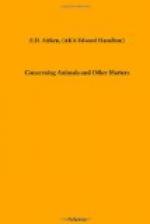But this explanation will not fit other cases. What a multitude of wild ducks there are in Scotland and every other country, mallards, pintails, gadwalls, widgeons, pochards and teals, all very much alike in their habits and tastes! But of them all only one species, and that a migratory one, the mallard, has been persuaded to abandon its wandering ways and settle down to a life of ease and obesity as a dependant of man. In India there is a duck of the same genus as the mallard, known as the spotted-billed duck (Anas poecilorhynchus), which is as large as the mallard and quite as tasty, and is, moreover, not migratory, but remains and breeds in the country. But it has not been domesticated: the tame ducks in India, as here, are all mallards. The muscovy duck is a distinct species which has been domesticated elsewhere and introduced.
From the ducks let us turn to the hens. The partridge, grouse and pheasant are all dainty birds, but if we desire to eat them we must shoot them, or (proh pudor!) snare them. Plover’s eggs are worth four shillings a dozen, but we must seek them on the moors. The birds that have covenanted to accept our food and protection and lay their eggs for our use and rear their young for us to kill are descended from Gallus bankivus, the jungle fowl of Eastern India. How they came here history records not: perhaps the gipsies brought them. They appear now in strange and diverse guise, the ponderous and feather-legged Cochin-China, the clean-limbed and wiry game, the crested Houdan, the Minorca with its monstrous comb, and the puny bantam. In Japan there is a breed that carries a tail seven or eight feet in length, which has to be “done” regularly like a lady’s hair, to keep it from dirt and damage.
But however their outward aspects may differ, they are of the same blood and know it. A featherweight bantam cock will stand up to an elephantine brahma and fight him according to the rules of the ring and next minute pay compliments to his lady in language which she will be at no loss to understand. And if the artificial conditions of their life were removed, they would soon all lapse alike to the image of the stock from which they are sprung. This is well illustrated in a show case in the South Kensington Museum exhibiting a group of fowls from Pitcairn’s Island. These are descended from some stock landed by the mutinous crew of H.M.S. Bounty in 1790, which ran wild, and in a century they have gone back to the small size and lithe figure and almost to the game colour of the wild birds from which they branched off before history dawned.




